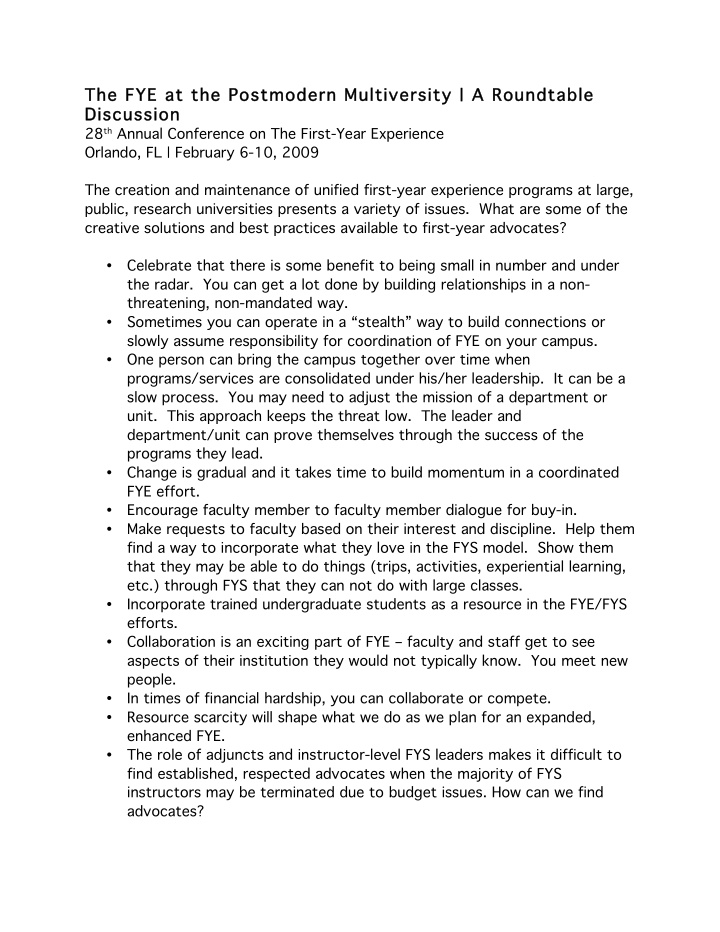



The FYE at the Postmodern Multiversity | A Roundtable Discussion 28 th Annual Conference on The First-Year Experience Orlando, FL | February 6-10, 2009 The creation and maintenance of unified first-year experience programs at large, public, research universities presents a variety of issues. What are some of the creative solutions and best practices available to first-year advocates? • Celebrate that there is some benefit to being small in number and under the radar. You can get a lot done by building relationships in a non- threatening, non-mandated way. • Sometimes you can operate in a “stealth” way to build connections or slowly assume responsibility for coordination of FYE on your campus. • One person can bring the campus together over time when programs/services are consolidated under his/her leadership. It can be a slow process. You may need to adjust the mission of a department or unit. This approach keeps the threat low. The leader and department/unit can prove themselves through the success of the programs they lead. • Change is gradual and it takes time to build momentum in a coordinated FYE effort. • Encourage faculty member to faculty member dialogue for buy-in. • Make requests to faculty based on their interest and discipline. Help them find a way to incorporate what they love in the FYS model. Show them that they may be able to do things (trips, activities, experiential learning, etc.) through FYS that they can not do with large classes. • Incorporate trained undergraduate students as a resource in the FYE/FYS efforts. • Collaboration is an exciting part of FYE – faculty and staff get to see aspects of their institution they would not typically know. You meet new people. • In times of financial hardship, you can collaborate or compete. • Resource scarcity will shape what we do as we plan for an expanded, enhanced FYE. • The role of adjuncts and instructor-level FYS leaders makes it difficult to find established, respected advocates when the majority of FYS instructors may be terminated due to budget issues. How can we find advocates?
• Partner with academic areas through orientation; how can the orientation director help communicate what the academic units need students to know? • Some institutions incorporate a FYS model where MW are large sections and F is reserved for smaller discussion groups. The FY students get smaller class sections and graduate students get teaching experience. This was successful because one academic unit started this model and they began to enroll students in their discipline. It turned into a recruiting tool. • Begin with students who are undecided or not tied to an academic program or are enrolled in a program without a strong FY structure. Provide a quality FYS experience for those most in need based on academic unit affiliation. • A key benefit for participation by smaller academic units is the access to students (i.e. people will know about Women’s Studies if they are exposed to it through a FYS). • Recruit faculty through a call for proposals; understand that you may need to call faculty as a follow up for individualized recruitment. • Introduce yourself to new faculty; take them to coffee to talk about FYE and FYS opportunities • Address retention issues for deciding students through a focused FY program • If a living community exists for deciding students, access it and promote services to help support retention and student success • The NACADA link has a resources to show the cost of not retaining students (NACADA retention resources: http://www.nacada.ksu.edu/Clearinghouse/advisingIssues/retain.htm • NC State has benchmarking information on an extended orientation option for deciding students • Assume the role of an advocate; speak up when things that are barriers to student success are identified; take the issue to the appropriate department or decision maker • Start the conversation on your campus: What does an oriented student look like? What are the associated outcomes or goals? Look for opportunities in existing programs and/or propose ways to fill the gaps. • Navigation of the campus resources and services can be an issue for students. How do we help student know where to go? Focus on this question by explicitly teaching “how to navigate a research institution.”
• Multiversities may not want to make a thoroughly “unified” FYE their goal; they may instead want to work toward flexible programs that emphasize coordination instead of unity. • If a FYE program has success in the student affairs area, it may be tough to sell to the academic side of the institution. • Involve the library in educating FY students. Help them understand how to use the library and navigate the services. • Recruit Deans/Associate Deans to teach courses first and then go to faculty and program coordinators. • The National Resource Center has a four page primer on current trends in the field. • When making proposals, provide support for your ideas or suggestions with institution specific information. • Joe Cuseo, Marymount College, has a lot of useful information for support of FYE. Kansas State University Gregory Eiselein, eiselei@k-state.edu, 785-532-0386 Professor of English and Coffman University Distinguished Teaching Scholar Emily Lehning, lehning@k-state.edu, 785-532-6237 Assistant Vice President for Student Life/Director of New Student Services
Recommend
More recommend